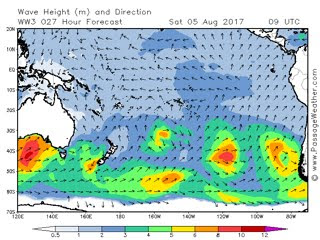Deep depths
by Isa Rosso
We are in the middle of another storm, and we've been sitting on station for several hours already. More than "sitting", we are making "weather patterns", that look like loops around the station. The ship is quite desert at the moment, and I have the lab all for myself. Who plays cards, who catches up with samples, who reads. There's almost none around. I am watching Harry Potter, and every 2 hours I go outside to check the sea state. The wind is roaring and the waves keep hitting the boat so hard, that few minutes ago it felt like we hit the Kraken!
Forecast for tomorrow (wave height and direction) by www.passageweather.com
I was thinking that, as sea going scientists, we get to explore incredible places, where just a very tiny number of people have been to. For example, after we crossed the IDL we reached one of the deepest trenches in the world, the Kermadec Trench. With its maximum depth of 10047 m of depth, the Kermadec Trench is the fifth deepest oceanic trench, to be precise. The trench, which is ~1200 km long, is formed by the subduction of the Pacific tectonic plate under the Indo-Australian Plate and represents the eastern boundary of the Kermadec Ridge. Apparently, the Pacific Ocean has the majority of trenches: Mariana, Auletian, Tonga…
Map of the South Pacific Ocean, where the black line shows the P06 line
The Kermadec Trench is particularly interesting also from an oceanographic point of view, as it is a location where deep and bottom waters coming from the Southern Ocean flow northward (via a deep western boundary current). To distinguish the different water masses, we need to look at different properties. For example, from the CTD profiles we can quickly look at the salinity and oxygen, and identify a high oxygen layer of fresh Antarctic Bottom Water (from the bottom up to ~4000 m) and the Lower Circumpolar Deep Water (between 3000 m to 4000 m), characterized by higher salinity and lower oxygen. Above, we can also find the old waters of the Pacific Deep Water, which are fresher and lower in oxygen than the Lower Circumpolar deep water (up to 1500 m).
Preliminary profiles of salinity (on the left) and oxygen (right) from one of the stations at the Kermadec Trench
The maximum depth we could explore was 6000 m, as the instruments would have broken below this depth. This is deeper than any other cast I've ever done! We all got really excited to decorate and shrink styrofoam cups at that depth, and to keep some of those waters as souvenir.
Styrofoam cups, ready for the trench (photo by Sabine Mecking)
We are now 13 days till Tahiti, about to shift the time of another hour on our clocks. Plans on what do do, where to hike, or which beaches to explore, are common topics of our conversations.. I can't wait to swim with sharks and whales!! :-)







Comments
Post a Comment